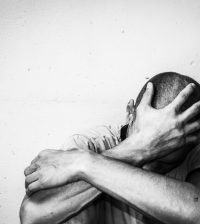- U.S. Births Declined in 2023, Marking End to Post-Pandemic Rise
- FDA Approves New Antibiotic Against UTIs
- New School Lunch Rules Target Added Sugars, Salt
- Dairy Cows Moved Across State Lines Must Now Be Tested for Bird Flu
- TikTok Riddled With Misleading Info on Health: Study
- Emulsifier Chemicals Are Everywhere in Foods. Could They Raise Diabetes Risk?
- Opioids During Pregnancy May Not Raise Psychiatric Risks for Offspring
- Could Heartburn Meds Raise Your Migraine Risk?
- Drug, Alcohol Abuse Goes Untreated in Many Ex-Prisoners
- Watchdog Group Says U.S. Food Recalls Rose Again Last Year
Light Box Might Help Nonseasonal Depression, Too

Light therapy, a treatment for a kind of depression known as seasonal affective disorder (SAD), may also benefit nonseasonal depression, a new study indicates.
“The combination of light and an antidepressant seems to work very well for treating nonseasonal depression,” said study leader Dr. Raymond Lam, a professor and head of the Mood and Anxiety Disorders Program at the University of British Columbia in Canada.
Depression, a leading cause of disability worldwide, affects one in 20 people, according to background information with the study. Current treatments include psychotherapy and antidepressant medication, but recurrent episodes are common.
Since bright light treatment is used for people whose seasonal depression occurs in the darker months, the researchers hypothesized it might also lift depression that isn’t brought on by light deprivation.
Lam and his team randomly assigned 122 adults with major depression not related to seasonal affective disorder to one of four groups. One group got 30 minutes of bright light treatment a day and took a placebo pill, while another used a device that was not light therapy and took the antidepressant fluoxetine (Prozac). A third group took a placebo pill and used a placebo device, while a fourth took Prozac and got light therapy.
The researchers followed the men and women for eight weeks, looking to see how many went into remission — defined as having normal scores on a widely used depression scale.
“About 60 percent of the patients who got the combination [Prozac plus light] treatment went into remission with their symptoms compared to about 40 percent on light therapy alone,” Lam said.
The antidepressant alone was not superior to placebo medication. Only about 30 percent of those on placebo medication and sham light treatment had remission, as did just 20 percent of those on Prozac with sham light treatment.
Light therapy alone was better than placebo, but not from a statistically significant point of view, Lam said.
Experts can’t say for sure why light therapy works, but for seasonal affective disorder they think it may help correct disturbances in the body’s circadian rhythms, or internal clock.
The same may be true for nonseasonal depression, Lam said. “Another theory is that light affects neurotransmitters in the brain such as serotonin [which affects mood],” he said. Or both could play a role, he added.
One limitation of the study, published online Nov. 18 in JAMA Psychiatry, is that patients’ natural light exposure was not measured, the researchers said.
Simon Rego is director of psychology training at Montefiore Medical Center and an associate professor at Albert Einstein College of Medicine in New York City. He said the study is the first well-designed comparison of light therapy and the combination of light therapy and antidepressant medications in adults with nonseasonal major depressive disorder.
“In this case, the authors found that the light treatment, whether delivered alone or particularly when delivered in combination with an antidepressant medication, was efficacious in the treatment of nonseasonal [depression] and, just as important, the treatments were well-tolerated by the subjects,” Rego said.
“It appears that light therapy, which is already seen as an effective treatment for seasonal affective disorder, may also be appropriate for nonseasonal [depression],” he added.
However, questions remain, Lam said, such as how long the combination treatment should continue.
Light boxes are sold at drugstores and other locations, Lam said, for less than $100 to $300. Some insurance plans cover them, he said.
Recommended treatment involves sitting in front of the fluorescent light box for a half hour daily as soon as possible after waking up. Lam said this can be done while eating breakfast or working on the computer.
The Canadian Institutes of Health Research funded the study. Lam reports serving as a consultant to or receiving honoraria for speaking from various pharmaceutical companies, including Eli Lilly and Co., which makes Prozac.
More information
To learn more about light box therapy, see Harvard Health Publications.
Source: HealthDay
Copyright © 2024 HealthDay. All rights reserved.










